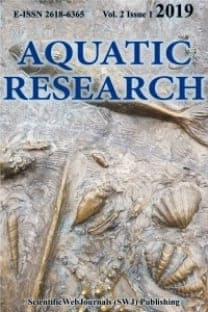A SURVEY ON MONITORING SYSTEM REQUIREMENTS OF TURKISH AND GREEK MARICULTURE INDUSTRY WITH ASSESSMENT OF PRODUCTION COMPLICATIONS
___
Buck, B.H., Chopin, T. (2018). State of the Art and Challenges for Offshore Integrated Multi-Trophic Aquaculture (IMTA) Sustainable Aquaculture Systems View project INTERNAS (Wissenschaftliche Übertragung der Ergebnisse von INTERnationalen ASsessments im Bereich Erde und Umwelt in den deutschen Politikkontext) View project. doi:10.3389/fmars.2018.00165Hsieh, C.Y., Tsai, M.H., Ryan, D.K., Pancorbo O.C. (2004). Toxicity of the 13 priority pollutant metals to Vibrio fisheri in the Microtox® chronic toxicity test. Science of the Total Environment 320, 37-50.
Edwards, P. (2015). Aquaculture environment interactions: Past, present and likely future trends. Aquaculture, 447, 2-14.
Eguiraun, H., Izagirre, U., Martinez, I. (2015). A paradigm shift in safe seafood production: From contaminant detection to fish monitoring - Application of biological warning systems to aquaculture. Trends in Food Science and Technology, 43(1), 104-113.
Lagarde, F., Jaffrezic-Renault, N. (2011). Cell-based electrochemical biosensors for water quality assessment. Analytical and Bioanalytical Chemistry, 400, 947- 964.
FAO, (2016). The State of World Fisheries and Aquaculture. doi:10.5860/CHOICE.50-5350
Ferreira, N.C., Bonetti, C., Seiffert, W.Q. (2011). Hydrological and Water Quality Indices as management tools in marine shrimp culture. Aquaculture, 318, 425-433.
Florentin, A., Lizon, J., Asensio, E., Forin, J., Rivier, A. (2016). Water and surface microbiologic quality of point-of-use water filters: A comparative study. American Journal of Infection Control, 44(9), 1061-1062.
Granada, L., Lopes, S., Novais, S.C., Lemos, M.F.L. (2018). Modelling integrated multi-trophic aquaculture: Optimizing a three trophic level system. Aquaculture, 495, 90-97.
Gao, G., Fang, D., Yu, Y., Wu, L., Wang, Y., Zhi, J. (2017). A double-mediator based whole cell electrochemical biosensor for acutebiotoxicity assessment of wastewater, Talanta, 167, 208-216.
Hancock, C.M., Rose, J.B., Callahan, M. (1998). Crypto and Giardia in US groundwater: Groundwater systems need to be carefully monitored until contamination levels and acceptable risk factors are determined. Journal - American Water Works Association, 90(3), 58-61.
Harun, A., Ndzi, D.L., Ramli, M.F., Shakaff, A.Y.M., Ahmad, M.N., Kamarudin, L.M., Zakaria, A., Yang, Y. (2012). Signal propagation in aquaculture environment for wireless sensor network applications. Progress in Electromagnetics Research, 131, 477-494.
Lemarchand, K., Lebaron, P. (2003). Occurrence of Salmonella spp. and Cryptosporidiumspp. in a French coastal watershed: relationship with fecal indicators. FEMS Microbiology Letters, 218(1), 203-209.
Little, D.C., Newton, R.W., Beveridge, M.C.M. (2016). Aquaculture: A rapidly growing and significant source of sustainable food? Status, transitions and potential, in: Proceedings of the Nutrition Society. Cambridge University Press, pp. 274-286. doi:10.1017/S0029665116000665
Ma, M., Tong, Z., Wang, Z., Zhu, W. (1999). Acute toxicity bioassay using the freshwater Luminescent Bacterium Vibrio-qinghaiensis sp. Bulletin of Environmental Contamination and Toxicology, 62, 247-253.
Pauly, D., Zeller, D. (2017). Comments on FAOs State of World Fisheries and Aquaculture (SOFIA 2016). Marine Policy, 77, 176-181.
Schmidt, W., Raymond, D., Parish, D., Ashton, I.G.C., Miller, P.I., Campos, C.J.A., Shutler, J.D. (2018). Design and operation of a low-cost and compact autonomous buoy system for use in coastal aquaculture and water quality monitoring. Aquacultural Engineering, 80, 28- 36.
Simbeye, D.S., Zhao, J., Yang, S. (2014). Design and deployment of wireless sensor networks for aquaculture monitoring and control based on virtual instruments. Computers and Electronics in Agriculture, 102, 31-42.
Rodriguez-Mozaz, S., Alda, M.J., Marco, M.P., Barcelo, D. (2005). Biosensors for environmental monitoring: a global perspective. Talanta, 65, 291-297.
- ISSN: 2618-6365
- Yayın Aralığı: 4
- Başlangıç: 2018
- Yayıncı: Nuray ERKAN ÖZDEN
Bedigama Kankanamge Kolita Kamal JİNADASA, Galagamage Sugandhi CHATHURİKA, Gabadage Dona Thilini Madurangika JAYASİNGHE, Champa Disala JAYAWEERA
İSTANBUL İLİ SU ÜRÜNLERİ KOOPERATİFLERİNİN TİCARİ OLANAKLARI VE SORUNLARININ İNCELENMESİ
İbrahim CENGİZLER, Selvinaz YAKAN, SELÇUK DUMAN, Ruhay ALDIK, Miray Etyemez BÜYÜKDEVECİ
Deniz D. TOSUN, Özkan ÖZDEN, Ferhat ÇAĞILTAY, Tam s BARD CZ, George MANTAS, Shane A. HUNTER
ACOUSTIC NOISE POLLUTION FROM MARINE INDUSTRIAL ACTIVITIES: EXPOSURE AND IMPACTS
Halit KUŞKU, Murat YİĞİT, Sebahattin ERGÜN, Ümüt YİĞİT, Nic TAYLOR
